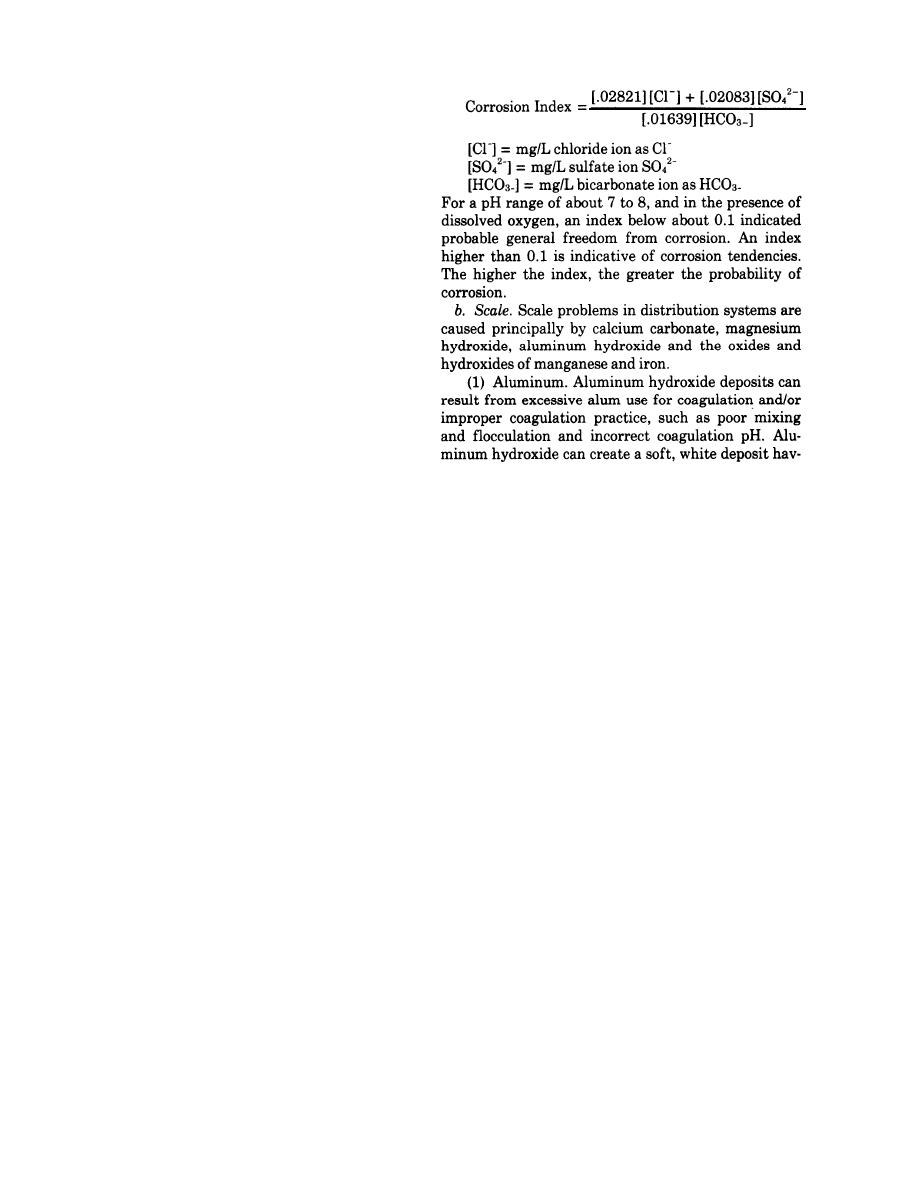
TM 5-813-3/AFM 88-10, Vol 3
interior is one widely used means of corrosion control.
This control method, while not infallible, has been
fairly successful in minimizing the corrosion rate of
iron pipe. The rate of formation of calcium carbonate
is favored by high concentrations of calcium and bi-
carbonate and carbonate alkalinity. Protection of this
type cannot be attained in waters containing very low
concentrations of calcium and alkalinity.
(3) Corrosion rates may also be reduced by the use
of certain inhibitors. For potable water systems, the
most practical inhibitors are silicates and certain poly-
phosphate compounds. Sodium silicate can be used to a
limited extent in very soft water. Polyphosphates can
be applied for scale as well as corrosion control. They
are considered most effective for corrosion control in
the pH range 5.0 to 8.0 and their effectiveness is great-
ly influenced by velocity. Low velocity, such as en-
countered in dead-end mains, reduces the effectiveness
of all corrosion control methods.
(4) Dissolved oxygen and carbon dioxide have a
significant effect on corrosion rates. Carbon dioxide
ing a rippled surface which will produce reductions in
lowers the pH and makes the water more aggressive.
pipe carrying capacity as measured by the Hazen-
Carbon dioxide can be removed chemically, but it is
Williams "C" value. The problem is one of "after pre-
generally not feasible to attempt chemical removal of
cipitation" of aluminum hydroxide; i.e., aluminum re-
oxygen from potable water supplies. Most surface
mains in solution until after filtration. Chlorination,
waters are normally saturated with oxygen while
which often follows filtration, will reduce the pH
ground waters, initially free of oxygen, usually absorb
slightly and the chemical nature of aluminum is such
some during treatment and distribution. When con-
that a slight reduction in pH will result in a significant
sidering the removal of carbon dioxide by aeration, it
reduction insolubility.
should be kept in mind that while efficient aeration
(2) Magnesium. Magnesium hydroxide deposits
will remove most of the carbon dioxide, it will, in
have caused serious difficulties in distribution systems
doing this, practically saturate the water with oxygen.
and hot water heaters. Magnesium volubility is highly
(5) Corrosion rates are influenced to some extent
sensitive to pH and temperature and failure to exercise
by all mineral substances found in water, but corrosion
careful control over its stabilization following sof-
effects are so interrelated that it is not possible to iso-
tening will usually lead to deposition problems. In the
late the quantitative influence of individual ions. It is
absence of detailed information regarding the scaling
known that high concentrations of chloride and sulfate
tendencies of a given water, it is advisable to maintain
ions will produce increased corrosion rates. However,
magnesium hardness below 40 mg/L and pH below 9.8.
their adverse effects are somewhat mitigated by alka-
Hot water heaters should be operated so that water
linity (carbonate, bicarbonate) and calcium ions. To ob-
temperatures will not exceed 140 F.
tain appreciable benefit from alkalinity and calcium,
(3) Iron and manganese. Hydrous oxide deposits
the total alkalinity, expressed as calcium carbonate,
of iron and manganese are inevitable in distribution
should be at least 50 mg/L, preferable in the range of
systems handling water containing more than about
50 to 100 mg/L. The calcium concentration, calculated
0,3 mg/L of iron and 0.05 mg/L of manganese. The
as calcium carbonate, should also be at least 50 mg/L.
severity of the problem is directly related to the con-
In general, the higher the concentrations of alkalinity
centration of iron and manganese and the best solution
and calcium, the greater is the water's capacity for cor-
is to remove them at the source. A less satisfactory
rosion retardation. On the other hand, excessive cal-
procedure is to attempt to prevent their precipitation
cium and alkalinity will often result in objectionable
by polyphosphate treatment at the source. Iron de-
scale formation. It is, therefore, necessary to seek a
posits may also be caused by corrosion reactions which
compromise between corrosion on the one hand and
form loose scale or tubercles. In severe cases, cleaning
scale formation on the other.
and lining of the pipe may be required. Tubercle
(6) Based on the corrosion accelerating effects of
formation can be minimized through corrosion control.
chloride and sulfate and the corrosion inhibiting ef-
c. Chemical Control of corrosion.
fects of alkalinity, the following ration, termed the
"Corrosion Index," has been developed.
(1) Calcium carbonate saturation,
2-26


 Previous Page
Previous Page
